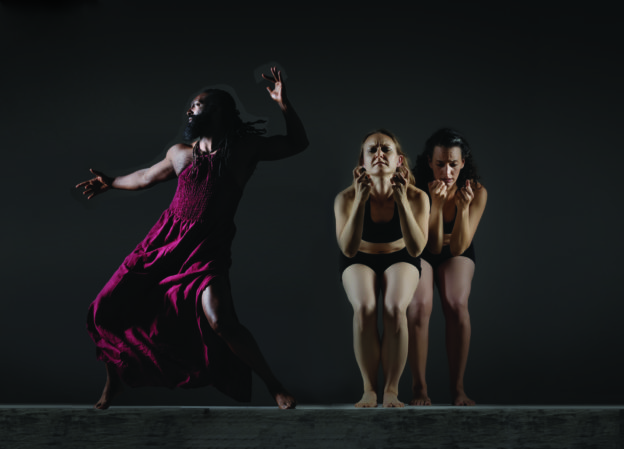We wear misapprehension on our sleeves as a humble offering of our humanity. This is about audience as much as it is performance. A work-in-progress of our own vantage. I prescribe this room as an inverse microcosm of Deaf diasporas. Antoine and performers communicate about how to begin; we sit in alerted silence. The ability to hear is trivial in kinesthetic constellations of knowing. I am taciturn and ignorant.
“Your truth is my truth,” Antoine intimates about the themes. The music begins with an auxiliary connection. Vibrations alert the performers of their cues. Performers Zahna Simon, Maim Mendelson and Kelly Garret then pave an emotional topography on white marley. A labored tedium, they crosshatch tally on the stage wall with unknown quantity. The dancers enter verberations of injustices with hands shackled and bodies swirling until rationale is blurred. We hear deep violins and cellos underscoring audible thumps. The performers stab, slit, and nurture their own weight only to let it dissipate on the stage. Later, performers peer over the ledge and holler to the audience with relentless eye contact. I hold back my innate applause. What’s my role as spectator?
It seems I don’t belong here. In this room, right here, attempting to package and consume the thematic overtones of these works. A hearing man, I couldn’t begin to encapsulate the realities of Deaf diaspora; when Deaf individuals are removed from their homeland and relegated to a prison system that is cruel, inhumane, and grossly maltreating. Deaf individuals are wrongly shot and killed by police when attempting to sign. A handcuff to a Deaf person occludes communication as a basic right.

Elsewhere, in prisons nationwide, accommodations like sign language interpreters, access to videophones and other assistive technology is neglected ubiquitously. Deaf inmates are assaulted by hearing inmates and guards alike; incorrect treatment by systems we refer to as correctional. Once victim to the justice system, the Deaf are subjected to the aptly dubbed prison within a prison.
These are the themes surrounding Antoine Hunter/Urban Jazz Dance Company’s new work, Deaf’s IMPRISONED. Four distinct works investigate the realities of multiple Deaf artists, a Deaf black man in prison, a woman of color.
The work was in part inspired by Joanna Haigood, Director of Zaccho Dance Theater. In 2011 Joanna invited Antoine to work on a dance piece entitled Dying While Black and Brown about African Americans on death row. During this process Antoine’s collaborators inquired about Deaf prisoners, catalyzing his research into the topic. “It pushed me to look deeper into the truth and encouraged me to work fast to get the message out,” Antoine tells me.
“How many deaf people are in prison?” Kelly Garret reads from a cell phone in the work-in progress. The answer: thousands, though most prisons don’t track the number, and none of this information comes across my news feed.
“My goal is for this work to instigate an inspired movement to correct and prevent wrongful convictions of Deaf individuals…and increase representation of the Deaf victims in the justice, legal and corrections professions,” says Antoine.
The dancers swivel limbs endlessly like clockwork. The labored exercise looks painful and then becomes grotesque as grimaces indicate a quality of self-sabotage. Their hands make movements I can’t read. Do their bodies, too? Salient to the hearing viewers, we inquire, Is there a level of communication that we’re not able to join? Then I remember, this daily dissonance is a perilous reality to the Deaf community.
In Deaf’s IMPRISONED, Antoine Hunter/Urban Jazz Dance Company welcomes Deaf artists to bring their personal trajectories of oppression and audism to the stage. Through storytelling, dance, spoken word, film, music, acting, and silence, we encounter prison in the abstract via a series of artist vignettes. What’s the reality for a Deaf woman of color? Christopher Smith, a Deaf, black, queer actor with Multiple Sclerosis, describes his life as “no picnic at all.” What can hearing audiences learn from his reality?
Antoine describes these works as “exploring the tension between Deaf diaspora and Deaf utopia.” He gives multiple examples. A Deaf child born in a hearing family, issued assistive technology in lieu of ASL and community. A Deaf inmate who’s too afraid of being abused to sleep or bath. Such diasporic partitions from Deaf homelands are honest and naked in Deaf’s IMPRISONED.
Utopia might be the polar opposite of these caustic realities, but paradise is a far cry from the narrative realities in Deaf’s IMPRISONED. These performative works deliver emotive pleas for justice. As a hearing spectator, it’s difficult to accept legal thresholds of equitable treatment as winning the battle; a matrix of intersectionalities complicates matters. Though we can begin by putting Deaf activism at the forefront of our social justice conversations in efforts to dismantle diasporic chains, both within prisons and outside the bars.
This article appeared in the November 2018 edition of In Dance.


